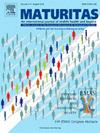The association between handgrip strength and metabolic syndrome: A large prospective Chinese cohort study
IF 3.9
2区 医学
Q2 GERIATRICS & GERONTOLOGY
引用次数: 0
Abstract
Objectives
Many studies have explored the association between handgrip strength and metabolic syndrome; however, the findings are inconsistent due to the different types of indicators used to assess handgrip strength (absolute vs. relative handgrip strength). This prospective cohort study aimed to simultaneously investigate the associations of both absolute and relative handgrip strength with metabolic syndrome, and to compare the predictive abilities of these two measures among Chinese adults.
Methods
Cox proportional hazards regression models were used to analyze 15,820 participants (49.7 % men) living in Tianjin, China. Handgrip strength was measured using a handheld dynamometer. Relative handgrip strength was normalized to body weight (kg).
Results
During the 6-year follow-up, there were 3385 incident cases of metabolic syndrome. The fully adjusted hazards ratios (95 % confidence interval) of the incidence of metabolic syndrome for increasing quartiles of relative handgrip strength were: 1.000 (reference), 0.871(0.780, 0.973), 0.675(0.602, 0.757), 0.454(0.401, 0.513) in men and 1.000 (reference), 0.830(0.714, 0.966), 0.561(0.471, 0.668), and 0.369(0.301, 0.452) in women (both P for trend <0.0001). The optimal cut-off of relative handgrip strength to predict incident metabolic syndrome was 0.563 kg/kg in men (sensitivity = 64.3 %, specificity = 55.6 %) and 0.436 kg/kg in women (sensitivity = 57.0 %, specificity = 69.3 %).
Conclusions
This large cohort study showed that higher relative handgrip strength, but not absolute handgrip strength, was associated with a lower risk of metabolic syndrome. Although handgrip strength may not be highly sensitive in screening for metabolic syndrome, it remains a valuable predictive tool due to its convenience, ease of measurement, and cost-effectiveness.
握力与代谢综合征之间的关系:一项大型前瞻性中国队列研究
目的探讨握力与代谢综合征之间的关系;然而,由于使用不同类型的指标来评估握力(绝对握力和相对握力),研究结果不一致。本前瞻性队列研究旨在同时探讨绝对握力和相对握力与代谢综合征的关系,并比较这两种指标在中国成年人中的预测能力。方法采用scox比例风险回归模型对天津市15820名参与者(男性49.7%)进行分析。用手持式测力仪测量握力。相对握力与体重(kg)归一化。结果6年随访中,共发生代谢综合征3385例。相对握力增加四分位数代谢综合征发生率的全校正危险比(95%可信区间)分别为:男性1.000(参考)、0.871(0.780、0.973)、0.675(0.602、0.757)、0.454(0.401、0.513),女性1.000(参考)、0.830(0.714、0.966)、0.561(0.471、0.668)、0.369(0.301、0.452)(趋势P均为0.0001)。相对握力预测代谢综合征的最佳临界值男性为0.563 kg/kg(敏感性= 64.3%,特异性= 55.6%),女性为0.436 kg/kg(敏感性= 57.0%,特异性= 69.3%)。结论:这项大型队列研究表明,较高的相对握力,而不是绝对握力,与较低的代谢综合征风险相关。虽然握力在代谢综合征筛查中可能不是高度敏感,但由于其方便、易于测量和成本效益,它仍然是一种有价值的预测工具。
本文章由计算机程序翻译,如有差异,请以英文原文为准。
求助全文
约1分钟内获得全文
求助全文
来源期刊

Maturitas
医学-妇产科学
CiteScore
9.10
自引率
2.00%
发文量
142
审稿时长
40 days
期刊介绍:
Maturitas is an international multidisciplinary peer reviewed scientific journal of midlife health and beyond publishing original research, reviews, consensus statements and guidelines, and mini-reviews. The journal provides a forum for all aspects of postreproductive health in both genders ranging from basic science to health and social care.
Topic areas include:• Aging• Alternative and Complementary medicines• Arthritis and Bone Health• Cancer• Cardiovascular Health• Cognitive and Physical Functioning• Epidemiology, health and social care• Gynecology/ Reproductive Endocrinology• Nutrition/ Obesity Diabetes/ Metabolic Syndrome• Menopause, Ovarian Aging• Mental Health• Pharmacology• Sexuality• Quality of Life
 求助内容:
求助内容: 应助结果提醒方式:
应助结果提醒方式:


